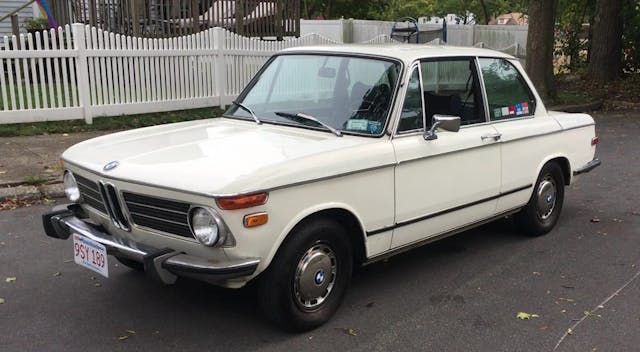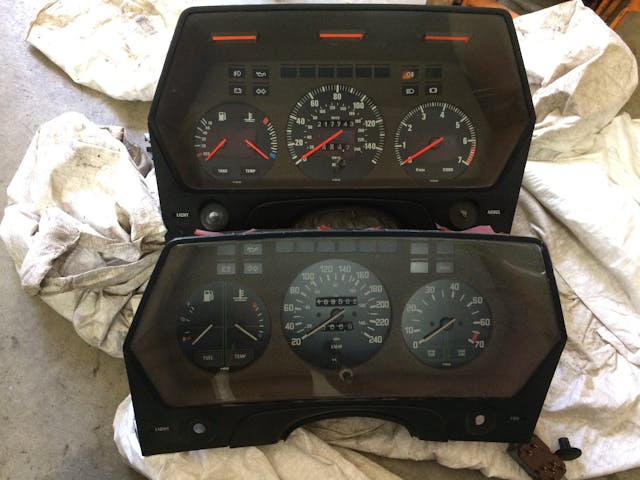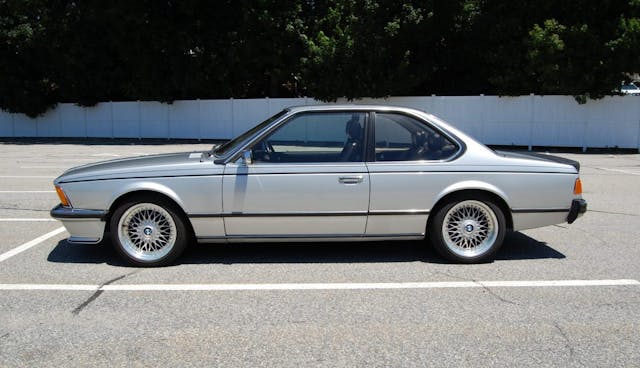When one of your cars just has to go … or, on second thought, maybe it doesn’t

I currently own 11 cars. There’s our two daily drivers and the Winnebago Rialta small RV, plus the seven vintage BMWs and the Lotus Europa on my Hagerty policy that must be tucked safely in a garage. As I’ve written before, there’s room in my 31×17 shoebox-dimensioned garage to comfortably fit three cars—four over the winter if I sardine them in place—and I rent four garages in Fitchburg, Massachusetts, about an hour from my house, which has room for another eight.
If I’m working on the cars and driving them, however, as I do in warmer weather, packing them in the garage makes it difficult to enjoy them for a quick drive.
The four garage spaces in Fitchburg each cost me $75/month, which sounds cheap—and by Boston standards, it is (that’s the value of driving an hour for garage space that’s not the tony suburbs where I live), but still, that’s $300/month, and when the bill comes due for the six-month lease, it means writing an $1800 check. Coming face-to-face with the cost of my passion certainly gives me pause.
So, with the pandemic causing driving and show events to be cancelled and scrambling everything having to do with automotive enjoyment, when I received the notice that it was time to renew the lease on the four spaces in Fitchburg, my left-brain reaction was that I should suck it up, do the responsible thing, sell one car, and rent one fewer space, a savings of $900 a year.
This is an exercise I go through regularly, and it’s fairly predictable, as most of the cars are with me for the long haul, so the finger keeps falling to the same one or two candidates. My 1999 BMW Z3 M Coupe (a.k.a. “the clownshoe”) doesn’t see a lot of road time, but when I do drive it, I’m instantly reminded that it’s completely unlike anything I own. Plus, I’m convinced that, if I sell it, I’ll experience a déjà vu of when I parted with my 1982 Porsche 911SC at exactly the wrong time and soon saw it triple in value. So it stays.

The obvious car to sell is actually the most recently-purchased—“Hampton,” the rust-free 1973 BMW 2002 with 48,000 miles that I bought last fall in Bridgehampton. I don’t usually buy cars knowing I’m likely to turn them over, but this one is an exception. I love 2002s (I own two others), but my tastes run to either fuel-injected 2002tiis or hot-rodded cars with Webers, a cam, and a stiff suspension, and although this bone-stock little white one is a jewel, it doesn’t really blow my skirt up. However, I’m not done prepping it, and I’m circumspect about the effect the ongoing pandemic may have on the Bring A Trailer value of the car, so sitting on it seems to be the thing to do.

And thus, the fickle finger of fate (“I got yer obscure 1971 Rowan and Martin’s Laugh-In reference right here, pal”) seemed to land on “the shark,” my 1979 BMW 635CSi. I wrote about sharks in general, and my car in particular, last year. It’s an early Euro car with the small bumpers, front air dam, and rear trunk lip, plus black stripes that look killer against the silver paint and black sport interior, giving it a look that just makes me weak in the knees—but I’ve barely driven it 20 miles since getting back from a 2000-mile trip to and from “The Vintage” BMW event two years ago and parking it one of the Fitchburg garage spaces. With no more road trips on the horizon, the logical thing to do seemed to be to move it along.

However, the car is difficult to value. Early Euro cars configured like this are desirable, but this one has several big strikes against it. First, it no longer has its torquey Euro-only 218-hp M90 engine and dogleg close-ratio five-speed, having been replaced at some point with a conventional U.S.-spec motor and overdrive gearbox. Second, clearly the car was smacked in the nose; rework of the inner fenders is evident. Third, it has 218,000 miles on it. These are all things that would be picked apart to death on Bring A Trailer and would prevent it from being bid up the way investment-quality cars are. But I decided to ready it for sale and float it on my Facebook page to get a bead on its value.

So, one sunny Sunday morning, I drove out to Fitchburg in one of the 2002s, swapped it for the shark, and found that the car’s inspection sticker had expired in December. I usually prefer to drive uninspected cars under cover of darkness, but I risked it and made it home without getting stopped.
As I was piloting the car through the streets of Fitchburg, heading for the highway, I was reacquainted with some of the car’s minuses. The big two-door coupe is nearly 16 feet long, and compared with my snappy little 2002s, the Z3 M Coupe, and certainly the Lotus, it feels like a bit of a whale. It’s certainly not a car you’d describe as “nimble.” It’s no wonder that it’s never been my ride of choice for a spirited stress-busting drive.
However, once I was on the highway, that downside vanished, and I was reminded that, of all my vintage BMWs (excluding the Z3 M Coupe), the shark is the best road trip car I have. It’s quiet, the windows actually seal so there’s very little wind noise, and the air dam keeps the nose planted at speeds above 80 mph where the other cars get light. And although it’s not my first choice for yeeeee-ha corner carving, it in fact performs that task just fine—it’s remarkably well balanced, goes where you point it, and the big sway bars keep it flat. The only downside I found was that the air conditioning I’d resurrected a few years prior had returned to non-functionality.
When I got home, I thought I’d step through the perfunctory pre-inspection check so I could get the car stickered first thing on Monday. To my surprise, I found that I had a headlight out, and I went down the rabbit hole correcting a wiring job on the adaptation of the Euro directional assemblies that was so shoddy it included a wire that was actually soldered to the bottom of the bulb. I fixed the lighting and got the car inspected the next day.

Then the real work began. As I always do, I wrote up the warts-and-all description, then treated it like a punch list. After all, it’s always better to fix something rather than have to apologize for it in an ad. Plus, when you go through this process, you naturally come up against the boundary between what’s easy to fix and what’s not. That is, you’re not going to change the car’s 218,000 miles, you’re not going to have long-ago bodywork redone, and you’re not going to swap back in an original drivetrain unless you find one on Craigslist for $500, but a sale does provide an opportunity to fix other things ranging from niggling little stuff to multi-day projects.
I began with the air conditioning. As I described in this piece about pressure-testing, I hooked up the manifold gauges, found the car empty of refrigerant, and used my nitrogen tank to find that the source of the leak was a deformed copper crush washer that had damaged one of the flare fittings. I had to cut the fitting off the end of a hose and crimp on another one.

Next, I put a surprising amount of time into figuring out the replacement engine. This was vital, because while it’s important to say that the car no longer had its original Euro-spec 218-hp M90 engine, it’s more instructive to say what it does have. The M90 is a variant of the M30 engine that was in “big six” cars from 1968–95. I spent several evenings researching block casting numbers and eventually determined that it was a 182-hp M30B34 motor with the Motronic digital engine management components removed and the original L-Jetronic system (or one like it) installed. The block serial number itself traced back to a U.S.-spec 635CSi. This isn’t the sexiest option (a 208-hp M30B35 would’ve been better), but at least it was a definitive answer.
The car’s original 3.07 differential had been replaced with a 3.45 to regain some oomph from the loss of its high-output original engine. Unfortunately, that threw the speedometer off. I figured it would be quickest and easiest if I simply swapped the whole instrument cluster, so over the winter I’d bought a cluster from a U.S.-spec 633CSi that had a 3.45 rear end. I pulled the original cluster and swapped in the replacement but found that its odometer wasn’t working. I swapped the original one back in and began looking at ordering a replacement odometer gear.

A cracked left rear taillight lens was replaced by a used one found on eBay.
A snotty interior rattle over rough terrain, sounding like one of those old doorstops that go thwaaaaang, turned out to be nothing more than an ill-secured rearview mirror. A little metal shim set it right.
The next issue on the list wasn’t nearly as trivial, as it involved the seat bolsters. Although the car’s interior is generally in very good condition, the black sport seats have flaws. They’re neither a ripped mess nor a spiderweb of cracks, but instead have bolster wear in specific places. Oddly, the passenger seat is the worst, with actual wear-through in the left bolster. I’ve re-foamed, re-bolstered, and re-dyed Recaro seats before, and considered doing so here. If the car had its original drivetrain and fewer miles, it would’ve been worth doing so, but I decided that the time and expense for the work wouldn’t move the needle enough.

I then put the car up on the mid-rise lift and thoroughly photographed the undercarriage, including the areas where rework of the inner fenders could be seen.
Then there was the cleaning, the photography, and the shooting of the videos, including a walk-around video that can be seen here, and a driving video.

If this sounds like a lot of work, it is. I find that, mechanical repairs notwithstanding, it usually takes me the better part of a couple of days to ready a car for sale, do the photography, shoot the videos, and prepare the description. I don’t do it unless I’m ready to sell.
With everything ready, I put the 200+ photos and videos in a Facebook photo album, pasted in my lengthy description, and prepared to float the car on my Facebook page on Saturday morning for maximum exposure. The purpose of “the float” isn’t to do the annoying “I’m thinking of selling my whatever, but I might not because I know what I’ve got” thing that you sometimes see. Instead, I use it as an opportunity to get feedback on a proposed price, and an opportunity for others to pounce on the car if they want it without risking getting outbid. When I’ve floated the last three cars, I’ve expected people to say, “That’s a crack-pipe price,” but instead I’ve had people meet my asking price without having to go through the auction process, saving everyone time, money, and effort.
When Saturday morning came, I was about to put the album up when re-watched the videos and realized that the driving video had issues. A windshield-mounted camera doesn’t show the tachometer as the engine winds out, but my hand-held phone work was awful, with periods of fingers over the lens. I decided I needed to re-shoot it. So, I went back out in the car. When I drove it again, during the wind-out shots I really put my foot into it and began thinking, “Gee, this M30B34 motor isn’t such a slouch.”
On Sunday morning, I edited the description one last time and stepped through all the photos. I then re-watched the walk-around video with the just-washed car gleaming in the sun, and something very surprising happened: I thought, “I can’t do it. I’ll regret it. It’s just too cool.” My right brain had stepped in and summarily overruled my left brain.
And that was that.
Decisions to sell a car can range from perfunctory to wrenching. I often say that if you beat yourself up and say, “I never should’ve sold that car,” you can console yourself with the observation that these decisions are usually based on the best information you have at the time, that cash flow and storage space are dear, and no one has a crystal ball on future values. But in this case, I realized that I didn’t really need the cash right now, that I had the storage space, and that, if I sold the car, rather than relinquishing one of the garages and saving the $75/month, in truth I’d be far more likely to just buy something else. It suddenly made much more sense to cap the number of cars and the number of garage spaces where they reside, and only make the tough choice to sell something if I find something else that I want more.
I have a friend, someone well-known in the vintage car community with a lot of experience in such things, who observed all this and said, “You’ll still sell it. You’ve already made up your mind that you can live without it. This is just a temporary reprieve.” Maybe, maybe not.
I am a believer that cars need to be for something, that one’s enjoyment of them is severely capped if they’re just sitting in a warehouse or behind a garage door. Without big events like The Vintage and the multi-day road trips there and back, or small events like Cars and Coffee, it’s challenging to find niches for cars. For now, the best I can do is to try to do a more consistent job of, during the driving season, cycling the cars the 50 miles back and forth between my house and Fitchburg and giving them all seat time rather than picking three and spending months at a time working on them as I have been.
So, I could say that the shark dodged a bullet (or, more accurately, a hook). But maybe it was in less danger than I thought. When you decide that one has to go, you can’t always change your mind and tell yourself maybe it doesn’t, but in this case, it feels right.
***
Rob Siegel has been writing the column The Hack Mechanic™ for BMW CCA Roundel magazine for 34 years and is the author of five automotive books. His new book, Resurrecting Bertha: Buying back our wedding car after 26 years in storage, is available on Amazon, as are his other books, like Ran When Parked. You can order personally inscribed copies here.

